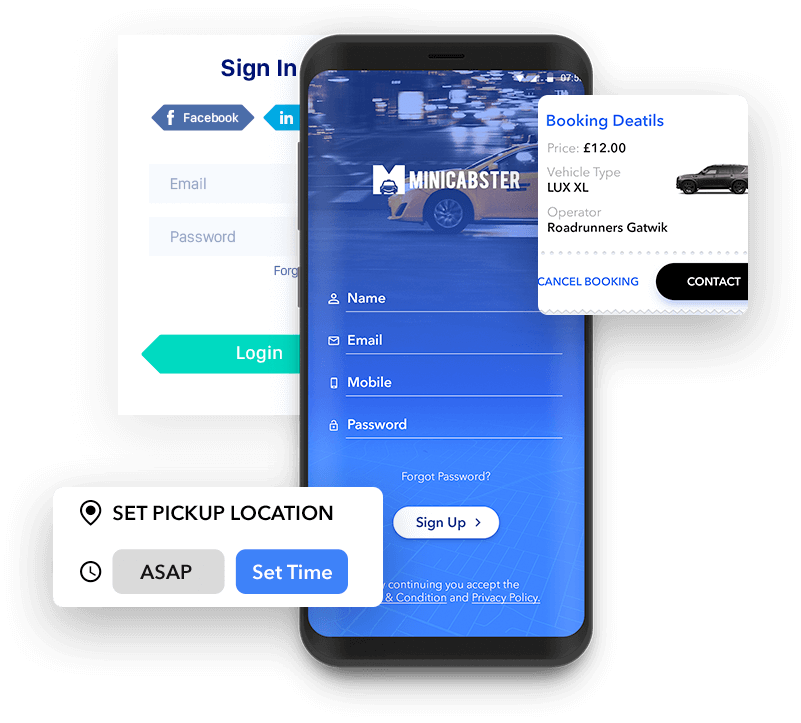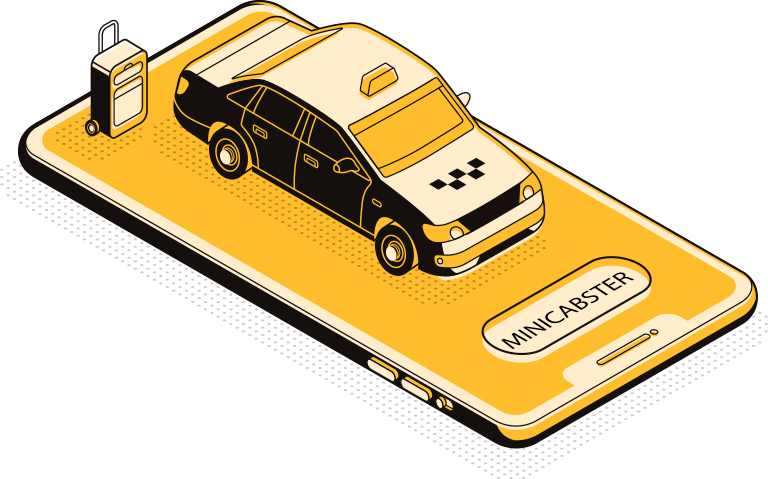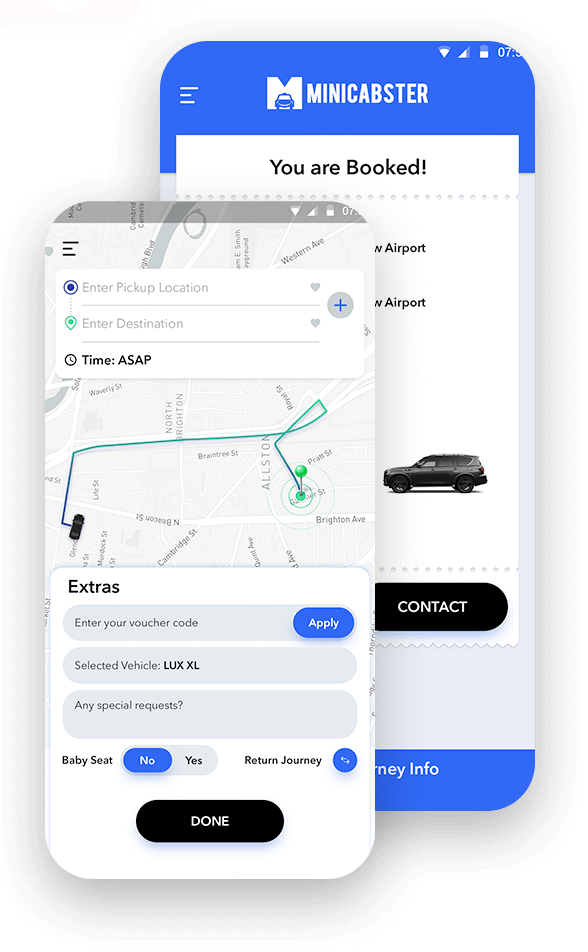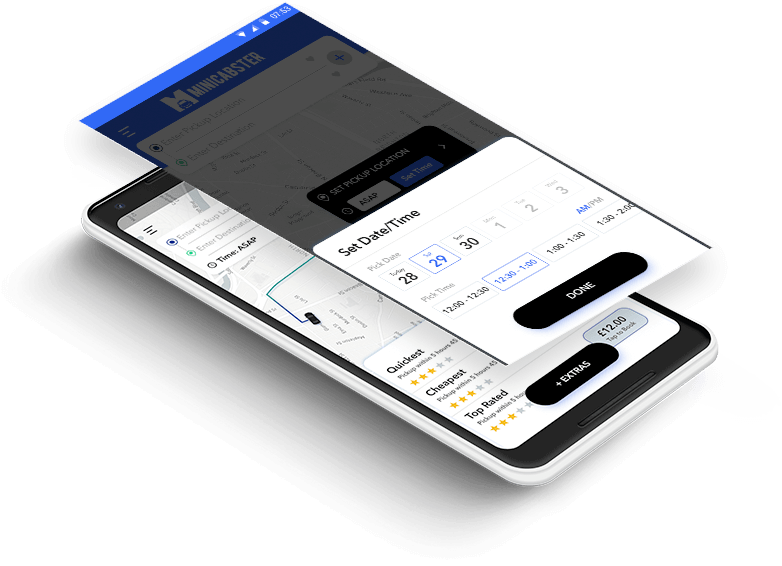

 +1 (512) 3331-934
+1 (512) 3331-934
 +1 (323) 5225-970
+1 (323) 5225-970
 +44 (161) 8188-928
sales@chromeinfotech.com
careers@chromeinfotech.com
+44 (161) 8188-928
sales@chromeinfotech.com
careers@chromeinfotech.com




Minicabster is the next frontier in the affordable, convenient, pleasurable and reliable taxi services. Browse your local fleets and get quotes for your journey upfront – all of them affordable and competitive.




Map Integration
to set Pickup and
Drop location

Requesting a Ride

In-app Payment

Cloud Hosting

Schedule a ride as per your convenience

Rate your drivers

Tracking real time driver location

Set of some favourite options.







This way passengers dont have to worry about a taxi not showing up, which sometimes happens with traditional taxi services.
The app tracks your location all the time – even when you're not using the app – which helps find the nearest driver within seconds.
Once a taxi has been ordered, you will be displayed a countdown until the driver arrives.

In the past few years, many taxi apps have popped up worldwide. To be ahead of its rivals, a taxi-booking startup needs to focus on building a network of drivers and passengers: that offer an equally pleasing experience to both parties. The International, as well as Domestic Success of Taxi Booking App Development triggered a rise in the Taxi business. Today, several other ride- hailing services are breaking the ground against traditional taxis.
Minicabster allows the customer to choose the ride based on these three rating options that are – Quickest ride, Cheapest ride, and Top Rated rides.
An option for corporate booking is available that can be used by companies and organizations to book taxis for their employees.
During high taxi demand or in any other circumstances, Minicabster does not surge prices of the rides.
This feature allows the user to add on a location that he/she wants to include in the ride journey. This application has an additional option to mention the number of suitcases the passenger is carrying.
The rider can user request for a child seat when booking a ride.


To build an amazing taxi-booking app, it is
important to hire a qualified Taxi App
Development Company and have them
develop the following features:

 Location Tracking
Location TrackingThe app needs to track your location all the time – even when you're not using the app – which helps find the nearest driver within seconds. Once a taxi has been ordered, to displays a countdown until the driver arrives. This way passengers don't have to worry about a taxi not showing up, which sometimes happens with traditional taxi services.
If you also want your app to track a rider's location while running in the background, don't forget to ask riders for permission to share their personal location data.
 Built-in Maps & Traffic Data
Built-in Maps & Traffic DataThe quality of the navigation experience can be a tipping point for drivers deciding which service to drive for. To get drivers from point A to point B, the app uses a variety of services. While the main source of location data Google Maps.
Take navigation pretty seriously. If you don't plan on global expansion in the first few months of your app's existence, you might not need that many location data sources. For iOS taxi app development, you can always use Apple's MapKit framework to embed a fully functional map interface into your taxi app. Or you can use Google Maps. Because...what could be better than Google Maps anyway? Here's how a map works: it contains a flattened representation of a user's surroundings. Coordinates (which can be specified by a user) are sent to the server, where they are translated into a readable address using Google's GSMGeocoder service. This process is known as reverse geocoding.
NOTE: Google Geocoder has limits on the number of requests it will process for free. Mind the pricing!
 Fare
FareWhen people hear the phrase "taxi price calculation," they tend to imagine a meter mounted to a car's dashboard. However, most cab booking apps don't operate that way.
We can calculate the fare using these four components:
Base fare – a flat fee for a ride; this value depends on the area and the Uber category
Cost per minute
Cost per mile
Booking fee (formerly known as the 'Safe Rides Fee') – a flat fee that covers 'operational costs' such as driver background checks
The cost per mile is calculated with the help of GPS — according to the mileage of the customer's route and your company's price list. The price of the ride needs to be submitted to the user before the car arrives.
 Payment Integration
Payment IntegrationAutomated payments almost feel like "payment-less" payments. The fact that you don’t have to reach for your wallet and hand over some cash makes it almost feels like you don't have to pay at all. We could still include a "pay with cash" option in addition to "pay with credit card" in taxi app. Presumably, some passengers might not have a credit card, or they might not want to charge money to their credit card for some reason. With a cash option, it's important to make sure a client doesn't change his or her mind and cancel the taxi when it arrives. To avoid this, you could place a security charge on a user's card (if they have a credit card of course). This is essentially a transaction, but the money is returned to the user's card once the service is rendered and cash has been paid. You can use Braintree to accept and manage online mobile payments. Their iOS SDK provides an easy-to- use collection of APIs for adding native payments to any taxi booking app. The Venmo touch network powered by Braintree technology even allows users to make one-tap purchases without having to input their credit card information over and over again. Braintree stores customer information and payment credentials in their Vault. This information is encrypted by the Braintree gateway and associated with a unique payment method token. We would also suggest that you consider the developer-friendly and robust Stripe APIs for both iOS and Android apps. Stripe secures card data by converting it into tokens on their Stripe servers.
 Rating System
Rating SystemTaxi app should be more reliable than traditional taxi services. They achieved this reliability by giving both riders and drivers more information than traditional taxi services both before and during the ride, and by implementing a rating system in the app. It's important for both riders and drivers to know who they're getting in the car with. A rating system increases the rider's and driver's sense of control and security, and also provides a curation mechanism to better match drivers with riders. Put simply, a rating system should be on your taxi app design agenda.
 Driver Focused Features
Driver Focused FeaturesToday, more and more taxi apps like Uber are emerging around the world. Uber is facing competition from all sorts of ridesharing apps. Didi Chuxing in China, Ola Cabs, and GrabTaxi in Asia, Lyft in the US – these are just a few examples out of hundreds of Uber rivals. In fact, Uber might soon face a threat from your taxi app as well!
While competing for customers is a huge challenge for new ride-hailing services, the competition for drivers might be even fiercer. Taxi companies often compete for the same pool of drivers. And it's hardly oversimplifying things to say that the taxi service that offers the most perks to drivers wins.
In answer to increasing competition, and also because Uber has been facing multiple lawsuits from drivers who accuse the company of wage theft, Uber has rolled out a few new driver-friendly features this year.
Now, Uber drivers in some US cities can "pause" new ride requests while on a route (without having to log off the app completely). They can also charge passengers for being two minutes late for a ride. Additionally, they can cash out their earnings at any time if they're driving the US roads.
Before getting down to implementing your taxi idea, consider other taxi apps which have already received millions of dollars in investments and have been mentioned in this article. Lyft, Hailo, Ola Cabs, GrabTaxi, EasyTaxi, and a dozen or so others should be on you competitor audit list.















We do our best work in close collaboration with our clients.
Let’s find some time for you to chat with a member of our team.